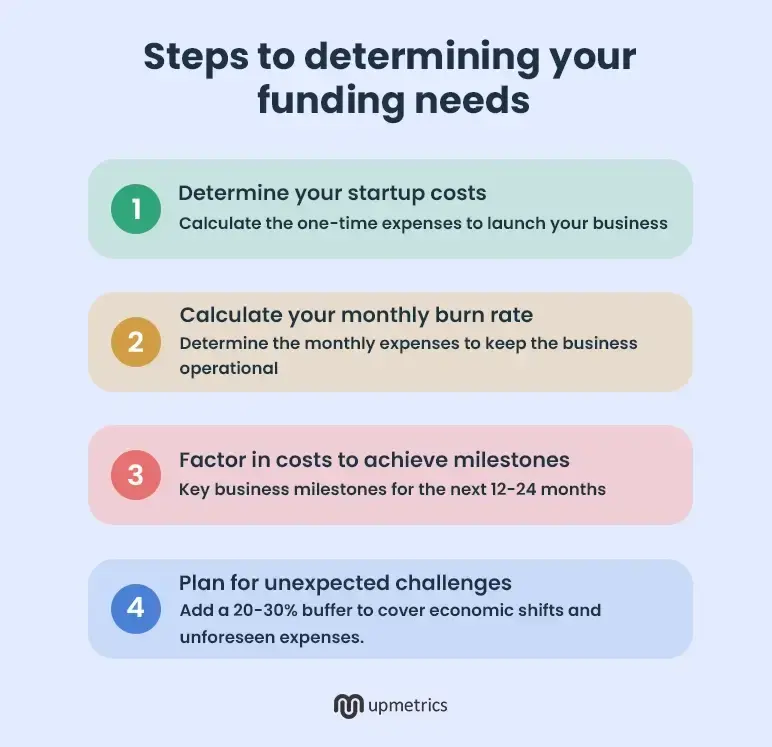Figuring out how much to raise isn’t as simple as adding up expenses and picking a number. Too little, and you’re scrambling for cash before you gain traction. Too much, and you’re giving away more equity than necessary.
Many founders fall into the trap of basing their ask on what competitors have raised or what feels like a safe number. But raising money isn’t about survival—it’s about buying time to reach a real milestone.
So how exactly do you figure out your funding ask:
A simple framework to get you started
Start by evaluating your business stage and why you need funding. Are you proving demand, scaling early traction, or optimizing growth?
The amount you raise should be directly tied to what you need to accomplish next, not just covering costs. That said:
1. If you’re pre-revenue: Raise an amount you need to prove demand
Your goal in the pre-revenue stage is validation. Your raise should cover expenses for:
- Building an MVP or prototype to test market fit
- Running paid experiments (ads, surveys, landing pages) to gauge demand
- Securing initial commitments or pilot customers to prove early traction
Investors at this stage care about validation. Your focus should be on securing capital to reach a point where customers are paying and you have proof of traction.
2. If you’ve traction: Raise enough to hit a revenue (or any other) milestone
With paying customers, you need to show growth is scalable and repeatable. At this stage, the raise should cover expenses for:
- Increasing sales capacity, i.e. hiring sales reps, partnerships, or automating acquisition to accelerate customer growth
- Expanding customer acquisition channels, i.e. ads, outbound sales, and referrals to lower CAC and boost conversions
- Improving onboarding and activation to reduce churn and strengthen retention metrics
3. If you’re scaling: raise based on capital efficiency
At this stage, it’s not just about growth—it’s about growing efficiently while controlling cash burn. Your raise should cover expenses for:
- Expanding into new markets or product lines
- Investing in automation, infrastructure, or process improvements to scale without excessive overhead
Now, what to raise for is only part of the equation—you also need to determine exactly how much capital it will take to get there.
Breaking down your funding needs
Let’s break down your funding needs with a structured approach so that you’re not just guessing, but making the right ask.

1. Determine your startup costs
Before focusing on growth, you need to calculate what it takes to launch and operate your business from day one. These are your one-time expenses—costs you must cover before generating revenue.
What this includes
- Product development: Building an MVP, purchasing inventory, or manufacturing the first batch
- Legal & administrative: Business registration, patents, trademarks, compliance fees
- Initial marketing & branding: Website, logo, design, and first promotional efforts
- Equipment & tools: Software, office space, machinery, or essential tech setup
The easiest way to start is by researching startup costs for your specific industry. And, while online estimates can serve as a baseline, your actual costs will vary based on location, scale, and business model.
The best is to conduct some preliminary research, i.e. contact suppliers, software providers, or contractors to get real pricing instead of relying on generic figures.
2. Calculate the monthly burn and runaway needs
How much money do you need to keep your business operational each month? This is your monthly burn rate, which includes both fixed and variable expenses you’ll incur regularly.
Understanding your burn rate is critical—it tells you how long your funding will last (runway) and when you’ll need to raise again.
Now, this part may seem straightforward from a purely mathematical perspective. However, most entrepreneurs miscalculate their runway because of two key blind spots:
- Underestimating costs that compound over time: Salaries don’t just mean paychecks; they come with benefits, payroll taxes, and overhead. Similarly, you need to account for office leases, software costs, and compliance fees that increase over time
- Overestimating revenue growth: Customers take longer to convert, paid ads don’t always deliver expected ROI, and market conditions shift. Relying on best-case revenue projections without a buffer can result in cash burn sooner than expected.
3. Factor in costs to achieve milestones
Now, map out the key milestones you plan to achieve in the next 12-24 months. This could include anything from venturing into a new country to making bulk hires, developing a key product feature, or hitting a revenue goal.
Quantify these milestones. For example, if you plan to hire 10 app developers, consider the cost of hiring them, including their salaries, benefits, and other relevant expenses such as equipment, software, and training.
Now, factor these costs into your cash flow forecasts to determine how much funding is required to execute these milestones without putting strain on your runway.
Remember, if your funding doesn’t carry you through a key milestone, you’re either raising too little or stretching your capital too far.
4. Buffer for unexpected challenges
Even the best financial plans fall short when unexpected challenges arise. Economic shifts, product delays, hiring gaps, or slower-than-expected customer adoption can drain cash faster than planned.
Relying on your best assumption isn’t enough. Build cash flow projections for worst-case scenarios so you’re not caught off guard by a sudden expense.
That’s it. After accounting for startup costs, burn rate, milestone expenses, and a buffer for uncertainty, you should now have a realistic funding target—one that’s based on actual business needs, not guesswork.
Key mistakes founders make while raising capital
Now, even with this structured approach, founders often make strategic mistakes that weaken their funding position, limit growth, or create long-term financial challenges.
- Raising too little: Raising little than required will result in cash burn and you seeking premature funding, which in all honestly, won’t arrive at favorable terms.
- Raising too much: Raising more than necessary will result in equity dilution, wasteful spending, and increased expectations from investors. Not to forget, there’ll be a loss of decisive freedom and control over your business.
- Can’t justify their ask: Logic alone won’t convince investors to invest. Your ask has to be justified with clear milestones, projected expenses, and expected returns.
- Not having pre-defined parameters: Not setting your terms and valuation parameters early on will result in you accepting terms that aren’t in your favor.
- Relying too much on best financial practices: Standard financial models don’t always account for the realities of early-stage startups. For instance, acquiring assets may be beneficial in the long run, but for early-stage startups, it also means excessive cash drain.
Turn funding uncertainty into a clear strategy with Upmetrics
With that, the answer to how much money should I raise shouldn’t be driven by emotion but by strategic planning and financial clarity.
Upmetrics supports exactly that. It provides a comprehensive business planning and financial modeling platform to help you map out your funding needs, future projections, and cash flow needs.
Upmetrics’s financial forecasting tool allows you to build projections for up to 10 years, test different scenarios, and build detailed financial statements from scratch. All without any complicated formulas or spreadsheets.
Ohh! And you also get to build your business plans for investor presentations in less than 10 minutes. It’s really that simple.
Stop waiting around and dive deeper into your funding needs with Upmetrics.


